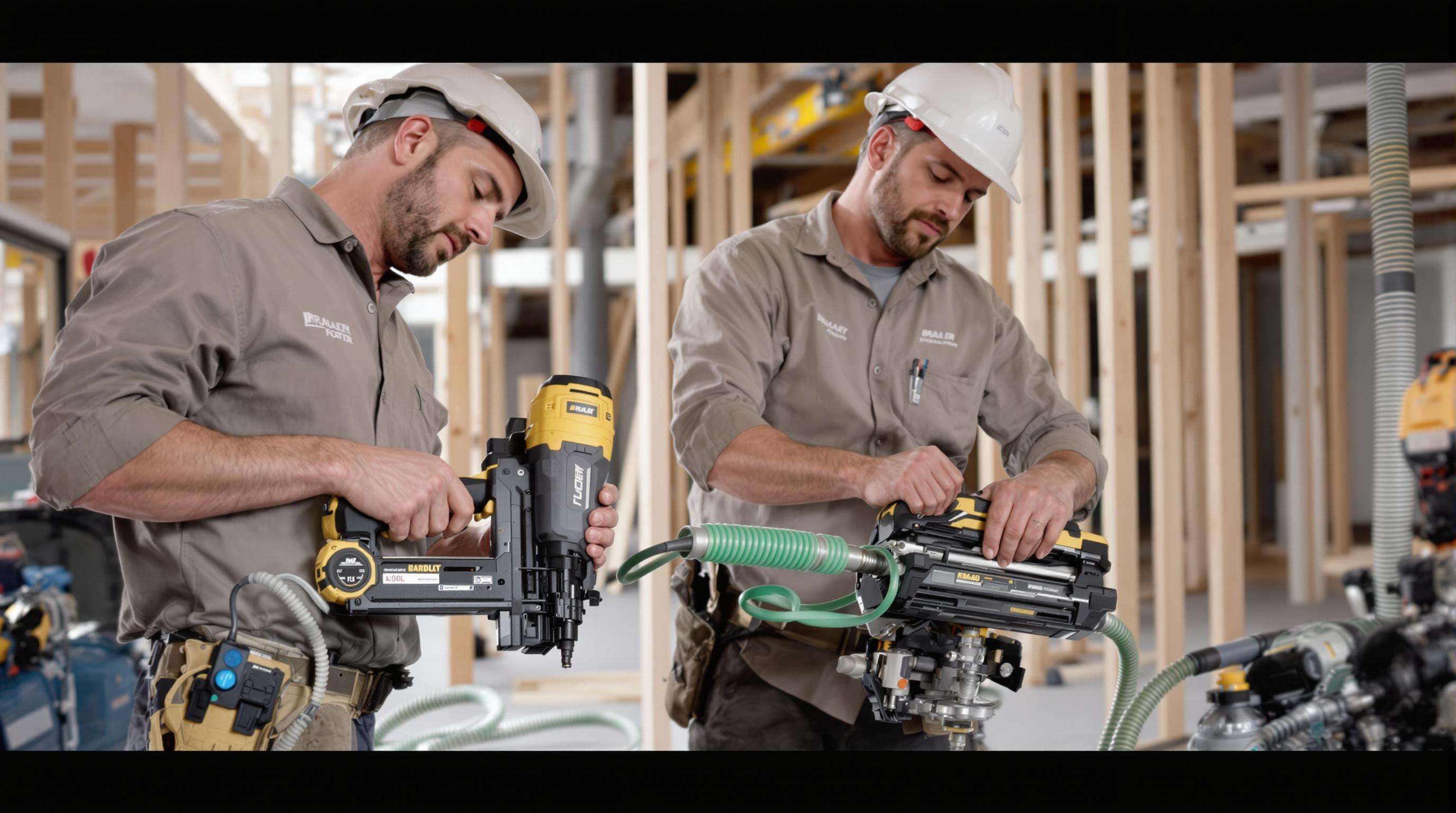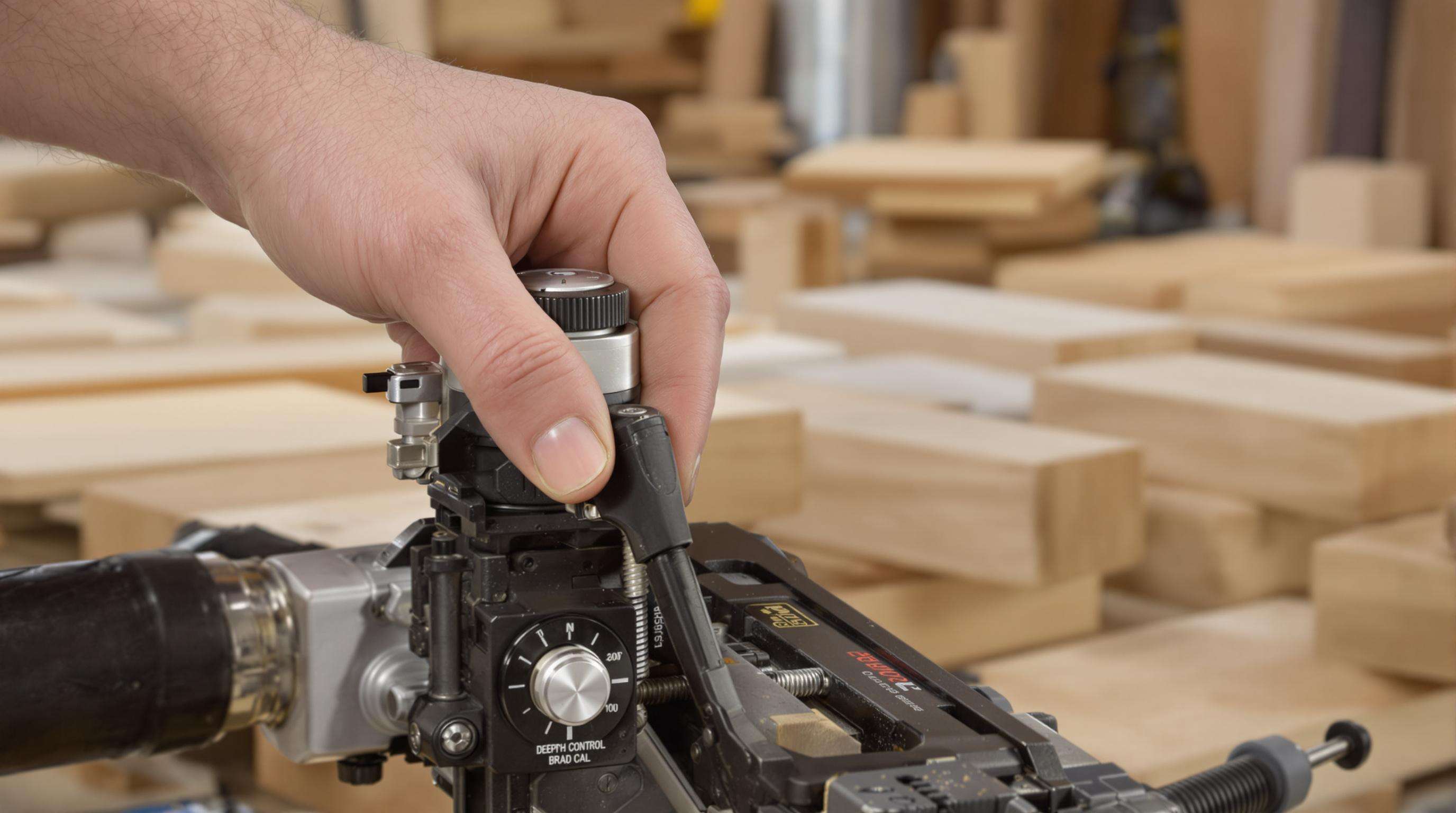Key Features to Consider When Purchasing a Brad Nail Machine
Power Source: Cordless vs. Pneumatic Brad Nail Machine Performance

Cordless vs. Pneumatic Brad Nail Machine: Pros and Cons
Cordless brad nail guns have really changed the game when it comes to getting around job sites without dragging along those bulky air compressors and tangled hoses. The downside? These tools usually tip the scales at about 30 to 40 percent heavier than their pneumatic counterparts according to recent industry reports from 2024, plus there's always that hassle of keeping batteries charged and swapped out regularly. On the flip side, traditional pneumatic nailers still hold their own in places where workers need to fire off hundreds of nails per hour. But anyone who's ever tried working on a second story roof knows what a pain those compressor cords can be, seriously limiting where someone can move around freely.
| Feature | Cordless Brad Nailers | Pneumatic Brad Nailers |
|---|---|---|
| Mobility | Unrestricted worksite use | Tethered to compressor |
| Maintenance | Brushless motors minimize wear | Regular lubrication required |
| Operating Cost | Battery replacement cycles | Compressor energy consumption |
Battery Life and Charging Time in Cordless Brad Nailers
Advanced lithium-ion batteries in premium cordless brad nailers drive 500–800 nails per charge, with rapid-charging systems replenishing power in under 30 minutes. Models compatible with interchangeable battery platforms allow seamless workflow continuity by swapping packs mid-job.
Performance and Reliability of Battery-Powered Brad Nail Machines
Nitrogen assisted drives are changing the game for cordless tools, letting them keep pace with traditional pneumatic ones. Some of the best models can fire off three nails every second, which is pretty impressive when looking at standard performance metrics. The tools also have sealed designs that stand up against dust buildup, plus those handy LED lights let workers know when there's a jam or if the battery needs charging. Testing in actual job sites shows these tools maintain around 98% accuracy after firing 10 thousand times. That kind of reliability makes them great choices for professionals doing detailed trim work or cabinet installations where consistent performance matters most.
Nail Gauge, Length, and Project Compatibility
Understanding 18-Gauge vs. 16-Gauge vs. 23-Gauge Brad Nail Machines
Selecting the correct nail gauge ensures proper fastening strength and material compatibility. Lower gauge numbers indicate thicker nails:
| Gauge | Thickness Range | Ideal Holding Power | Common Uses |
|---|---|---|---|
| 16 | 0.062–0.072" | High | Cabinetry, door/window frames |
| 18 | 0.047–0.051" | Moderate | Trim, crown molding |
| 23 | 0.025–0.029" | Low | Delicate wood, veneers |
18-gauge nails offer the best balance for general trim work, while 23-gauge minimizes surface damage on fragile materials.
Matching Nail Length and Gauge to Project Requirements
Nail length determines penetration depth and joint stability. For baseboards or molding, 1–1.5" 18-gauge nails provide secure hold without splitting wood. Furniture assembly often requires 16-gauge nails up to 2.5" long. Always confirm your brad nail machine supports the specified nail length—mismatched sizes lead to jams or incomplete drives.
How Nail Gauge Affects Holding Power and Material Suitability
In framing simulations, 16-gauge nails withstand lateral stress 27% better than 18-gauge fasteners (Fastener Engineering Report 2023), making them ideal for load-bearing joints. Meanwhile, 23-gauge nails reduce wood splitting by 43% in dense hardwoods like oak and mahogany. Match gauge to material: thicker nails for hardwoods, finer gauges for softwoods and composites.
Depth Control, Firing Modes, and Operational Precision

Precision depth adjustment is a hallmark of professional-grade brad nail machines. A 2023 NER Institute study found micro-adjustable depth controls reduced material tear-out by 42% compared to fixed-depth models, enabling optimal performance across softwoods, hardwoods, and composites.
Modern tools offer two firing modes: sequential (single-shot) for detailed finish work and contact (bump fire) for faster production. Contractors in a 2024 Builders' Association survey reported 31% faster installation with contact mode, while 78% preferred sequential mode for precision trim.
Safety-focused selective actuation uses dual-stage triggers requiring 2.5 lbs of pressure—23% higher than basic models—reducing accidental discharges. Field data shows these OSHA-compliant systems lower worksite injuries by 19% (Construction Safety Quarterly, 2023), especially during angled or overhead nailing.
Ergonomics, Weight, and User Comfort for Extended Use
How Weight and Balance Impact Brad Nail Machine Usability
A good balance makes all the difference when it comes to brad nailers, helping folks hit their marks better and not get so tired after hours of work. Most top quality units clock in between three to five pounds these days, though our tests last year showed they average around 3.6 pounds give or take. What matters most is how the weight feels in hand, since manufacturers design them to put most of the heft close to where fingers wrap around the handle area, which takes some pressure off the wrists over time. According to industry reports from earlier this year, pros who grabbed balanced tools managed to drive about thirty percent more nails each hour compared to workers stuck with heavier or awkwardly weighted alternatives on the job site.
Design Features That Enhance Ergonomics and Reduce Fatigue
Key comfort innovations include:
- Contoured handles with soft-grip zones aligned to natural hand positioning
- Anti-vibration systems reducing operational tremors by up to 67% (NIOSH 2022)
- Rubberized triggers requiring only 8–12 lbs of actuation force
These features help prevent cumulative trauma disorders, especially given that carpenters average 387 trigger pulls per hour (OSHA workplace surveys).
User Feedback on Comfort and Handling Across Top Models
Professionals consistently rate magnesium-bodied brad nailers higher for overhead tasks due to their light weight, while steel-frame models remain favored for durability in floor-level, high-volume jobs. In a 2024 survey of 1,200 trade professionals, 78% ranked "all-day comfort" as their top consideration when upgrading tools—surpassing both power and cost.
Durability, Build Quality, and Warranty for Long-Term Value
Materials and Construction Standards in Brad Nail Machines
Professional-grade brad nailers use high-grade aluminum housings and hardened steel internals. Units with reinforced nail feeds and overmolded rubber grips experience 27% fewer premature failures in 2023 tool reliability studies, particularly in demanding trim applications. For humid conditions or treated lumber, select models with sealed bearings and corrosion-resistant hardware.
Warranty and Service Agreements: Lifetime vs. Multi-Year Plans
Most leading brands offer 3-year tool warranties, though 40% of professionals prioritize extended battery coverage for cordless models. Lifetime warranties typically exclude wear items like driver blades and magazine springs, whereas select 5-year "bumper-to-bumper" plans cover all mechanical components except consumables.
Field Data on Long-Term Reliability Across Brands
Pneumatic brad nailers typically last 15,000–20,000 cycles before needing seal replacements. Cordless models maintain accurate depth control for 8,000–12,000 fires per battery lifecycle. Magnesium-housed tools demonstrate 33% better heat dissipation during continuous operation compared to ABS plastic models, enhancing durability in sustained use.
FAQ Section
What is the main difference between cordless and pneumatic brad nailers?
Cordless brad nailers are battery-powered, offering greater mobility without the need for compressor hoses, while pneumatic brad nailers require a connection to an air compressor, providing consistent power for high-volume nailing.
What nail gauge should I use for delicate woodwork?
For delicate wood and veneers, 23-gauge nails are recommended due to their low holding power and minimized surface damage.
How do ergonomic features of brad nail machines impact user comfort?
Ergonomic features like contoured handles and anti-vibration systems reduce fatigue and enhance comfort, allowing professionals to work longer with less strain.
What warranty coverage should I look for in brad nail machines?
Consider warranty plans that cover mechanical components and extend battery coverage for cordless models. Lifetime warranties may exclude some wear items, while multi-year "bumper-to-bumper" plans offer comprehensive protection.
 EN
EN
 AR
AR
 BG
BG
 CS
CS
 FI
FI
 FR
FR
 DE
DE
 EL
EL
 HI
HI
 IT
IT
 JA
JA
 KO
KO
 PL
PL
 PT
PT
 RU
RU
 ES
ES
 TL
TL
 ID
ID
 LT
LT
 SR
SR
 UK
UK
 VI
VI
 SQ
SQ
 GL
GL
 HU
HU
 MT
MT
 TH
TH
 TR
TR
 AF
AF
 MS
MS
 AZ
AZ
 KA
KA
 BN
BN
 LO
LO
 LA
LA
 MI
MI
 MN
MN
 NE
NE
 KK
KK
 UZ
UZ

